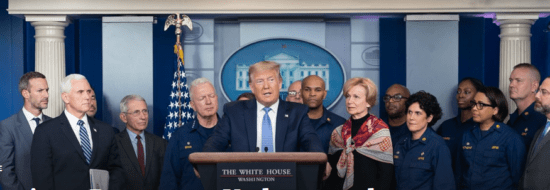Last night President Trump signed what is being called the second coronavirus stimulus bill. It provides for free coronavirus screening, $1 billion in additional unemployment insurance funding to all states, a bump in Medicaid FMAP, $1 billion in food aid, and two provisions to provide paid sick leave to employees.
Emergency Paid Sick Leave
This provision gives 80 hours or 2 weeks of paid sick leave to individuals who work for employers with fewer than 500 employees. This applies to all employees, both full time and part-time with part-time receiving leave equal to the average number of hours worked. There is also no tenure of employment requirement. This leave is available to workers who are:
- In self-isolation because of a coronavirus diagnosis
- Obtaining a diagnosis or care due to coronavirus symptoms
- Complying with an order to self-isolate because of exposure to someone with coronavirus
- Caring for a family member with a diagnosis or symptoms
- Caring for a child without access to daycare or school because of closure.
If the employee falls under the first 3 categories, they are entitled to full pay, but if work is missed to care for a family member or a child without access to school or daycare only two-thirds of pay is due. An employer cannot force an employee to use existing, traditional sick leave first.
Emergency Family and Medical Leave Act (EFMLA)
If after the first 2 weeks, the employee needs additional days, the EFMLA will be triggered. The existing FMLA provides 12 weeks of unpaid leave, but this emergency measure would provide that up to 10 weeks of that emergency eave that would be paid. The first two weeks under EFMLA would remain unpaid and during the following 10 weeks employees would be entitled to two-thirds of their pay.
Like the emergency paid sick leave provision, EFMLA would be for those diagnosed with coronavirus, caring for a family member diagnosed, and caring for a child without access to daycare or school. Unlike the paid sick leave provision, employees must have worked for 30 days and there is a hardship exemption for small business with under 50 employees. Under the hardship exemption, the US Department of Labor is given the authority to develop regulations to exempt a small business if EFMLA threatens the viability of the business.
The United States Secretary of Labor has the authority to issue regulations for good cause to (1) exclude certain health care providers and emergency responders from the definition of eligible employee; and to exempt small businesses with fewer than 50 employees when the imposition would jeopardize the viability of the business.
Tax Credit for Employers
Employers would be eligible for a refundable tax credit of 100 percent of qualified sick leave wages paid and family leave wages paid against their employer-side payroll tax liability. Employers can claim a quarterly tax credit against payroll taxes for payments associated with these 2 provisions up to the total payroll taxes in that quarter.
Medicaid
The bill temporarily increases the Medicaid FMAP in all states by 6.2% beginning in the calendar quarter of the emergency and ending the quarter it is declared over. Coronavirus testing must also be provided with no cost sharing. Those eligible will only lose coverage if they leave the state.
The bill also creates a new Medicaid eligibility category for the uninsured. Uninsured individuals would only be eligible to receive diagnostic testing for coronavirus, no treatment, but that testing would be done at no cost and reimbursed at 100% FMAP.
Unemployment Insurance
As states expand the criteria for unemployment to include coronavirus reasons, the US Labor Department reported 281,000 new claims for unemployment insurance last week, a 70,000 jump over the previous week. The bill gives states $1 billion for unemployment insurance nationwide that will provide relief to those who are facing coronavirus-related job loss. The unemployment aid would be broken in two separate payment structures. The first 50% of the grant would be sent to states for State Unemployment Agency staffing, technology, and other administrative costs so long as the states comply with three provisions in the bill. (1) Require employers to provide notification to the potential UI eligibility to laid off workers; (2) ensure that workers can apply for benefits in person, by phone, or online; two of the three must be available; (3) the state must notify applicants when an application is received and being processed and if the application cannot be processed, what information is needed to successfully process the claim. Currently, the State of Alabama would meet the current requirements to receive their portion of the first $500 million package. The other $500 million would be reserved for an emergency grant package for those states that may have seen at least a 10% increase in unemployment. There is also flexibility built into the unemployment provision with the goal of making it easier for workers to access unemployment benefits by waiving waiting weeks and work search requirements.
States could potentially be eligible for Extended Benefits (EB) for unemployment compensation programs when the unemployment rate surpasses certain thresholds to trigger EB programs. The first extended benefits trigger could allow for an additional 13 weeks of unemployment benefits after a claimant exhausts current state benefits (14 weeks of state UI benefits).
Food Assistance
The bill adds $500 million to provide access to nutritious foods to low-income pregnant women or mothers with young children who lose their jobs or are laid off due to the COVID-19 emergency through the Special Supplemental Nutrition Program for Women Infants and Children (WIC). There is also $400 million to assist local food banks to meet increased demand for low-income Americans during the emergency. The work requirement for the supplemental nutrition assistance program (SNAP) is also suspended. There are also provisions to provide funding and flexibility in the free and reduced lunch program if a school is closed for 5 consecutive days and for at home delivery of meals to the elderly.
